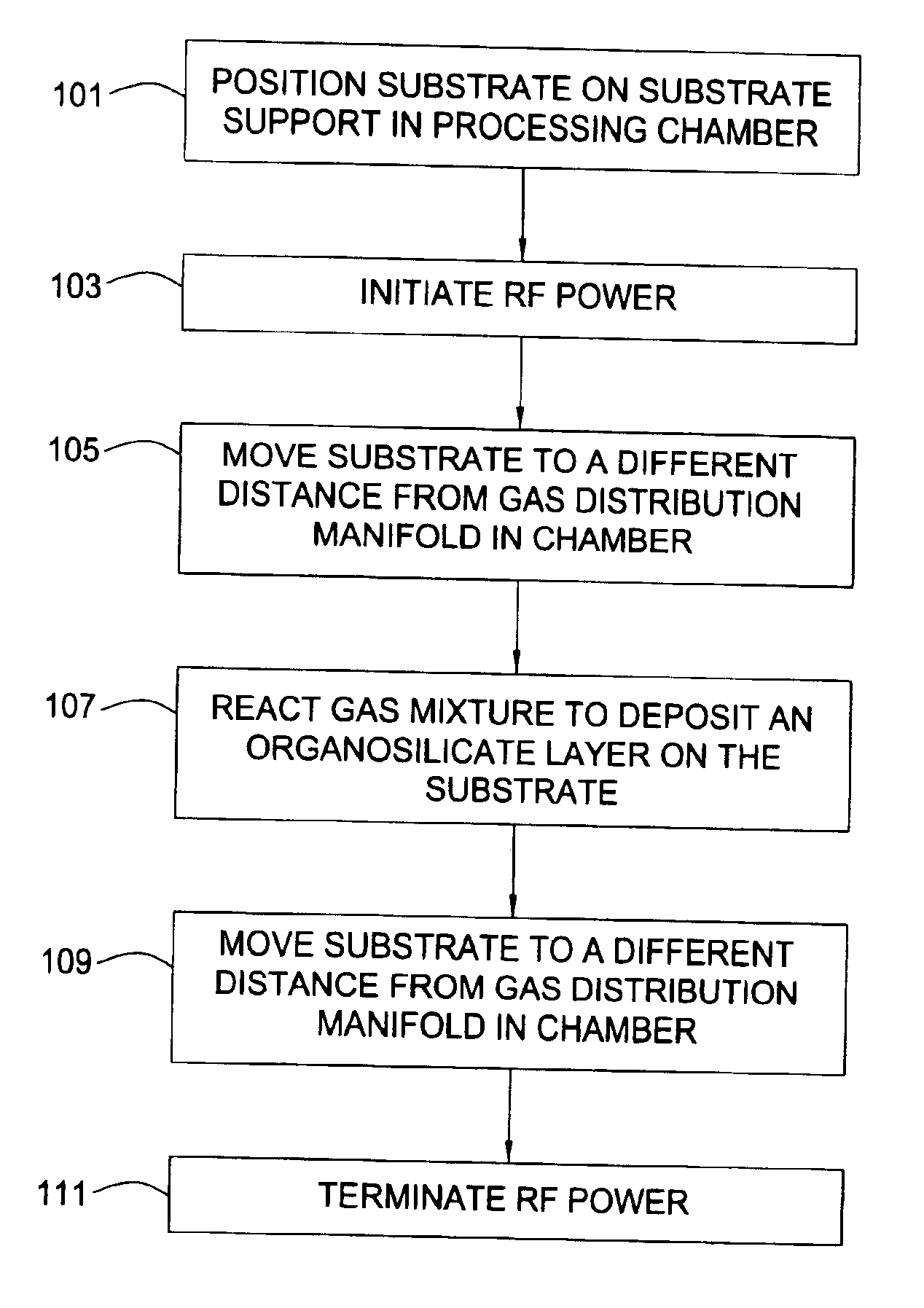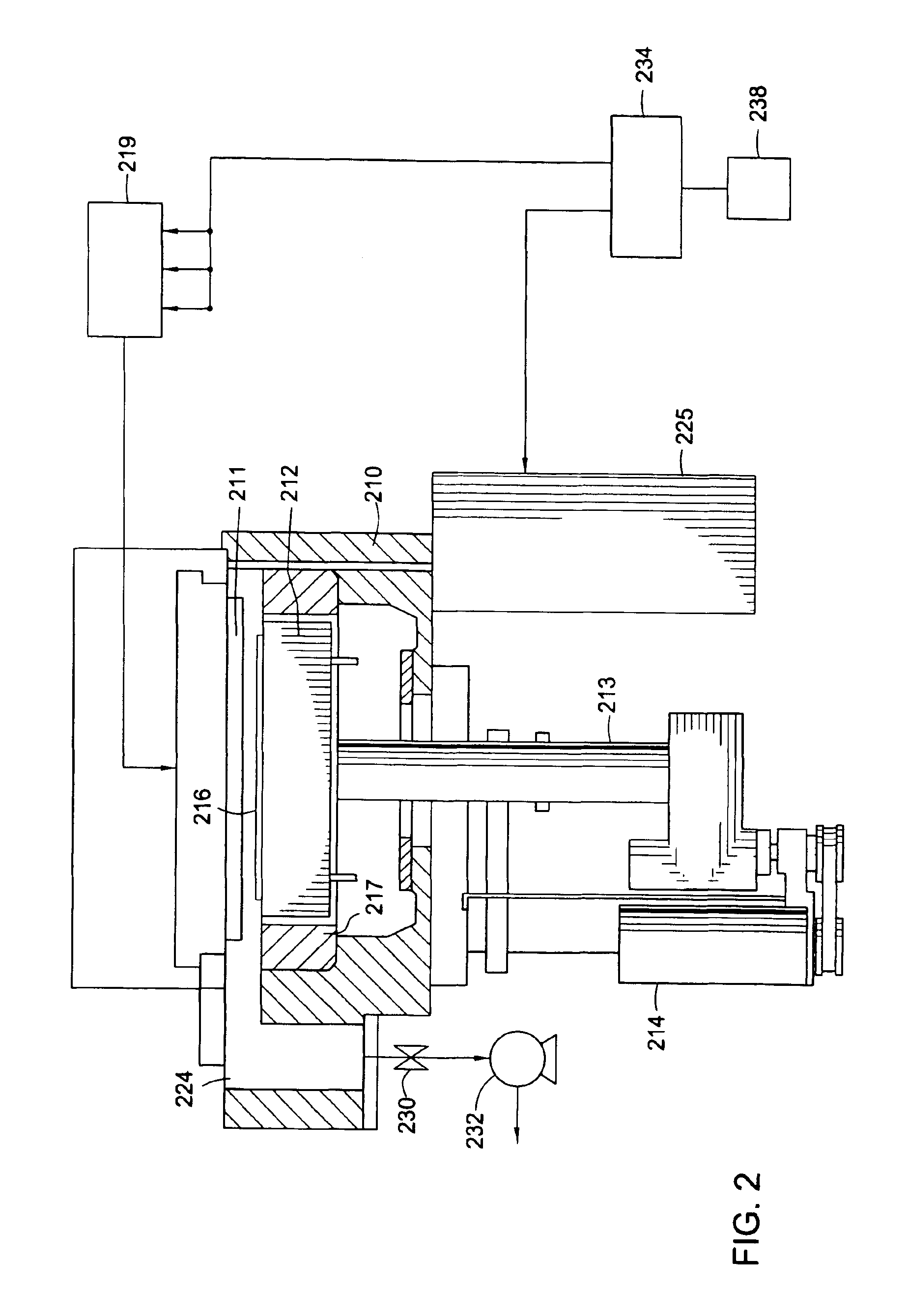Methods of reducing plasma-induced damage for advanced plasma CVD dielectrics
a dielectric and plasma technology, applied in the field of organosilicate layer depositing on the substrate, can solve the problems of many types and stages of devices that can experience plasma-induced damage (pid), device damage, and device damage, and achieve the effect of minimizing the damage of the substra
- Summary
- Abstract
- Description
- Claims
- Application Information
AI Technical Summary
Benefits of technology
Problems solved by technology
Method used
Image
Examples
example 1
[0047]An organosilicate layer was deposited on a substrate from the following gas mixture at a chamber pressure of about 5.75 Torr and substrate temperature of 400° C.:[0048]Octamethylcyclotetrasiloxane (OMCTS), at about 520 sccm;[0049]Trimethylsilane (TMS), at about 300 sccm,[0050]Ethylene, at about 2,200 sccm;[0051]Oxygen, at about 1,000 sccm; and[0052]Helium, at about 1,000 sccm.
[0053]The substrate was positioned 300 mils from the gas distribution manifold, and RF power of 2.5 W / cm2 (800 W) at a frequency of 13.56 MHz was applied to the manifold. The gas mixture described above was introduced into the chamber before the initiation of RF power. After initiation of the RF power for about 2 seconds, the substrate was positioned 1050 mils from the gas distribution manifold for deposition of the organosilicate layer in about 20 seconds. The substrate was then positioned 700 mils from the gas distribution manifold, and the RF power was terminated in about 2 seconds, while maintaining t...
example 2
[0054]An organosilicate layer was deposited on a substrate from the following reactive gases at a chamber pressure of about 5.75 Torr and substrate temperature of 400° C.:[0055]Octamethylcyclotetrasiloxane (OMCTS), at about 520 sccm;[0056]Trimethylsilane (TMS), at about 300 sccm;[0057]Ethylene, at about 2,200 sccm;[0058]Oxygen, at about 1,000 sccm; and[0059]Helium, at about 1,000 sccm.
[0060]The substrate was positioned 1020 mils from the gas distribution manifold, and RF power of 2.5 W / cm2 (800 W) at a frequency of 13.56 MHz was applied to the manifold. The gas mixture described above was introduced into the chamber before the initiation of RF power. After initiation of the RF power for about 2 seconds, the organosilicate layer was deposited in about 20 seconds. The substrate was then positioned 700 mils from the gas distribution manifold, and the RF power was terminated in about 2 seconds. The chamber pressure was maintained at about 5.75 Torr and the gas mixture was retained in th...
example 3
[0061]An organosilicate layer was deposited on a substrate from the following reactive gases at a chamber pressure of about 5.75 Torr and substrate temperature of 400° C.:[0062]Octamethylcyclotetrasiloxane (OMCTS), at about 520 sccm;[0063]Trimethylsilane (TMS), at about 300 sccm;[0064]Ethylene, at about 2,200 sccm;[0065]Oxygen, at about 1,000 sccm; and[0066]Helium, at about 1,000 sccm.
[0067]The substrate was positioned 1020 mils from the gas distribution manifold, and RF power of 2.5 W / cm2 (800 W) at a frequency of 13.56 MHz was applied to the manifold. The gas mixture described above was introduced into the chamber before the initiation of RF power. After initiation of the RF power for about 2 seconds, the organosilicate layer was deposited in about 20 seconds. The flow of the octamethylcyclotetrasiloxane and the trimethylsilane was terminated, and then the RF power was terminated in about 2 seconds while maintaining the chamber pressure. After the RF power was terminated, the flow...
PUM
| Property | Measurement | Unit |
|---|---|---|
| dielectric constant | aaaaa | aaaaa |
| frequency | aaaaa | aaaaa |
| frequency | aaaaa | aaaaa |
Abstract
Description
Claims
Application Information
 Login to View More
Login to View More - R&D
- Intellectual Property
- Life Sciences
- Materials
- Tech Scout
- Unparalleled Data Quality
- Higher Quality Content
- 60% Fewer Hallucinations
Browse by: Latest US Patents, China's latest patents, Technical Efficacy Thesaurus, Application Domain, Technology Topic, Popular Technical Reports.
© 2025 PatSnap. All rights reserved.Legal|Privacy policy|Modern Slavery Act Transparency Statement|Sitemap|About US| Contact US: help@patsnap.com



